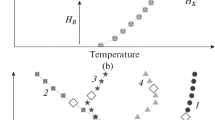Abstract
This study considers the problem of upper boundary conditions with regard to simulating the phenomenon of airflow over mountains. A two-dimensional stationary nonlinear analytical model is used. In a three-layer upstream flow, the velocity does not depend on the height, and the vertical temperature gradients change from layer to layer. The lower layer is the troposphere, the middle layer is the lower stratosphere, and the upper layer is the whole upper atmosphere unlimited in height. The impact of changes in stability of the middle layer on the wave energy reflection from the upper layers and, finally, on tropospheric disturbances is examined. It is confirmed that the energy reflection especially grows when the middle-layer temperature gradient approaches the dry-adiabatic value, because the environmental resilience to vertical displacements in air particles disappears. It is shown that, even in such a case, energy reflection is not full and, consequently, the Long resonance is not possible in the atmosphere.





Similar content being viewed by others
REFERENCES
V. N. Kozhevnikov, Atmospheric Disturbances in Airflow around Mountains (Nauchnyi mir, Moscow, 1999) [in Russian].
V. N. Kozhevnikov, “Modeling of atmospheric disturbances over the Crimean mountains,” Izv., Atmos. Ocean. Phys. 55 (4), 344–351 (2019).
R. R. Long, “Some aspects of the flow of stratified fluids. III. Continuous density gradients,” Tellus 7 (3), 341–357 (1955).
G. Lyra, “Theorie der stationären Leewellenströmung in freier Atmosphäre,” Z. Angew. Math. Mech. 23 (1), 1–28 (1943).
V. N. Kozhevnikov, “A review of the state of the art of the theory of mesoscale orographic inhomogeneities of the field of vertical currents,” Tr. Tsentr. Aerol. Obs. 98, 3–40 (1970).
D. R. Durran, “Another look at downslope windstorms. Part I: On the development of analogs to supercritical flow in an infinitely deep, continuously stratified fluid,” J. Atmos. Sci. 43, 2527–2543 (1986).
A. Gill, Atmosphere–Ocean Dynamics (Academic, London, 1982; Mir, Moscow, 1986).
A. A. Shestakova, K. B. Moiseenko, and P. A. Toropov, “Hydrodynamic aspects of the Novorossiysk bora episodes in 2012–2013,” Izv., Atmos. Ocean. Phys. 51 (5), 534–545 (2015).
V. N. Kozhevnikov and A. S. Losev, “On the model of air flow over a cylindrical corrugation with exact boundary conditions,” Moscow Univ. Phys. Bull. 37 (5), 48–54.
V. N. Kozhevnikov, Candidate’s Dissertation in Physics and Mathematics (Moscow State University, Faculty of Physics, Moscow, 1965).
Author information
Authors and Affiliations
Corresponding author
Rights and permissions
About this article
Cite this article
Kozhevnikov, V.N. On Taking into Consideration the Upper Layers of the Atmosphere to Simulate Orographic Disturbances in the Troposphere. Izv. Atmos. Ocean. Phys. 57, 142–147 (2021). https://doi.org/10.1134/S0001433821020079
Received:
Revised:
Accepted:
Published:
Issue Date:
DOI: https://doi.org/10.1134/S0001433821020079




